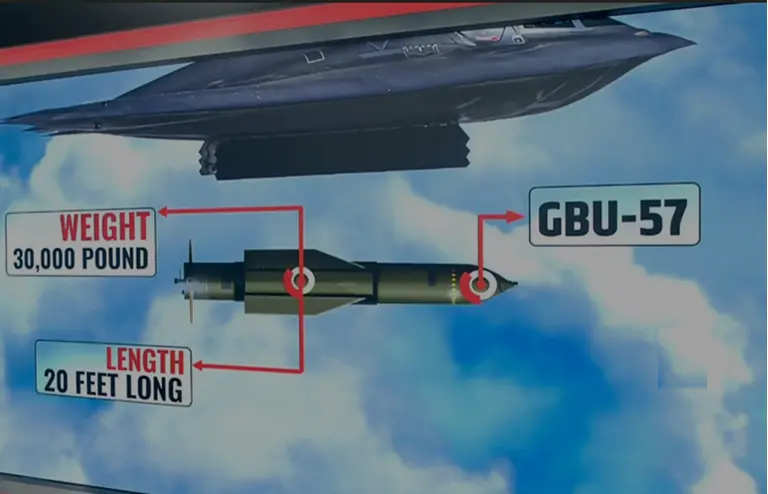
The UN nuclear watchdog confirms “very significant” damage to Iran’s Fordow enrichment plant after a US airstrike using bunker-buster bombs (videograb-ndtv)
Operation Midnight Hammer: A Strike Beneath the Mountain
US Bunker Busters – On June 22, 2025, the United States launched a high-stakes military operation targeting Iran’s most fortified nuclear site, the Fordow Fuel Enrichment Plant, buried deep beneath a mountain near Qom. The mission, dubbed Operation Midnight Hammer, involved B-2 Spirit stealth bombers dropping GBU-57 Massive Ordnance Penetrators, the most powerful non-nuclear bombs in the US arsenal.
Table of Contents
The Fordow facility, designed to withstand conventional attacks, was believed to be nearly impenetrable. But the use of bunker-buster bombs changed the equation. According to UN nuclear watchdog chief Rafael Grossi, the strike likely caused “very significant” damage to the underground centrifuge halls. These halls housed uranium enrichment equipment capable of producing material close to weapons-grade levels.
Grossi emphasized that the International Atomic Energy Agency (IAEA) has not yet been able to inspect the site due to ongoing hostilities. However, given the vibration-sensitive nature of centrifuges and the explosive payload used, the damage is expected to be extensive.
Strategic Fallout: What the Strike Means for Iran and the World
The Fordow strike is more than a tactical blow, it’s a strategic earthquake. The facility was central to Iran’s nuclear ambitions, with over 400 kg of uranium enriched up to 60% purity stored on-site. That’s just a short step from weapons-grade material, enough for multiple nuclear warheads if further enriched.
The attack follows weeks of rising tensions, including Israeli strikes on Iranian military infrastructure and Iran’s retaliatory missile launches. The US intervention marks a sharp escalation, signalling Washington’s willingness to directly engage in the conflict.
Iran has yet to disclose the full extent of the damage but has vowed to take “special measures” to protect its nuclear assets. Meanwhile, the IAEA has called for maximum restraint and urged all parties to return to diplomatic negotiations.
The Strait of Hormuz, a vital oil transit route, remains a flashpoint. Any Iranian move to block it could send global oil prices soaring and trigger a broader economic crisis.
Global Reactions and the Road Ahead
The international community is on edge. While the US claims the strike was necessary to prevent Iran from reaching nuclear breakout capability, critics warn it could undermine years of diplomatic progress. Russia and China have condemned the attack, calling for an emergency session of the UN Security Council.
In Washington, officials maintain that the operation was not aimed at regime change, but rather at neutralizing a critical threat. “This was a precision strike to degrade Iran’s nuclear capabilities, not an act of war,” said a Pentagon spokesperson.
Back in Vienna, Grossi reiterated the IAEA’s commitment to nuclear oversight, stating, “We must account for every gram of enriched uranium. Transparency is non-negotiable.” However, with inspections suspended and tensions soaring, the path to verification remains murky.
For now, the world watches and waits. Will Iran retaliate militarily, escalate through proxies, or return to the negotiating table? The answers will shape not just the future of the Middle East, but the global nuclear order.
US Bunker Busters truth
The US strike on Fordow has shattered the illusion of invulnerability surrounding Iran’s underground nuclear program. As the dust settles, the world faces a stark choice: escalate toward confrontation or recommit to diplomacy. One thing is certain, the nuclear clock just ticked closer to midnight.
Stay updated with the latest news on Rapido Updates. Keep yourself updated with The World, India News, Entertainment, Market, Automobile, Gadgets, Sports, and many more